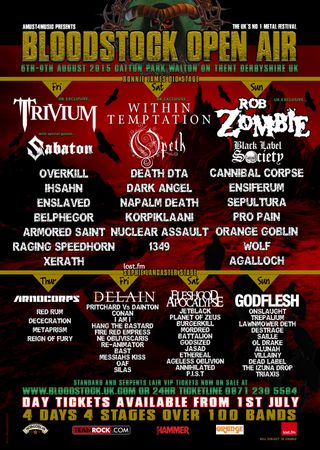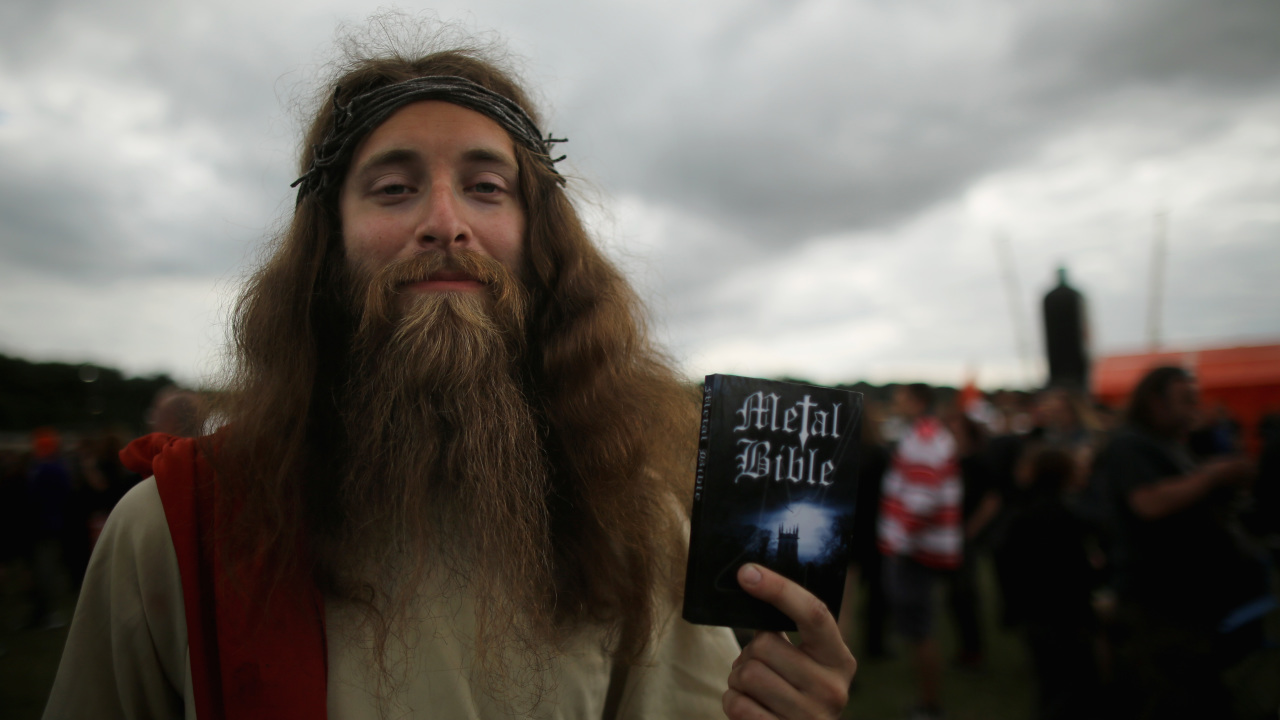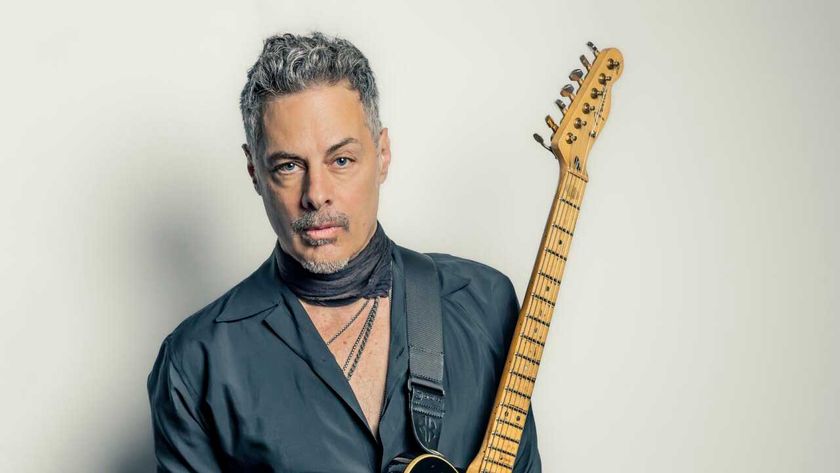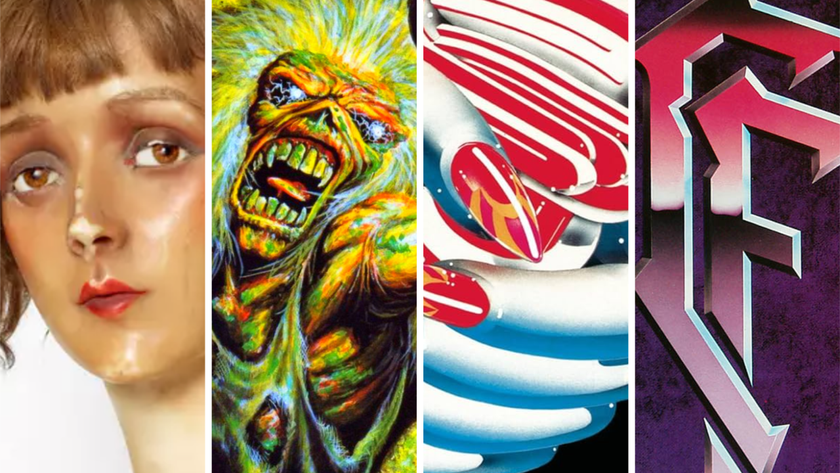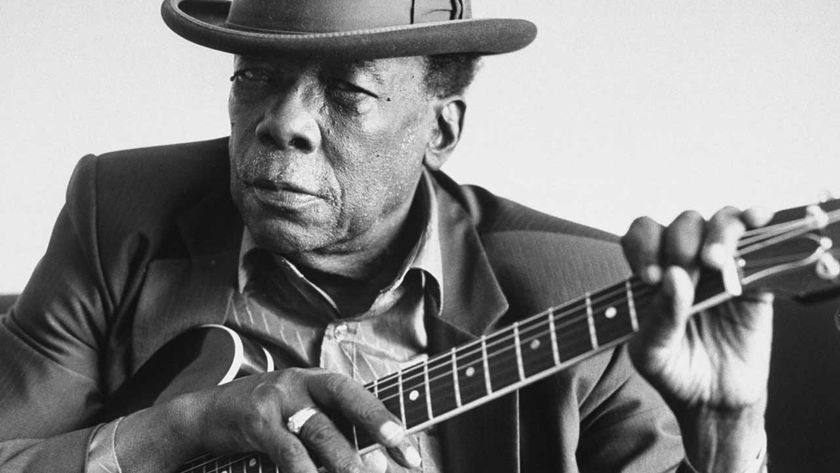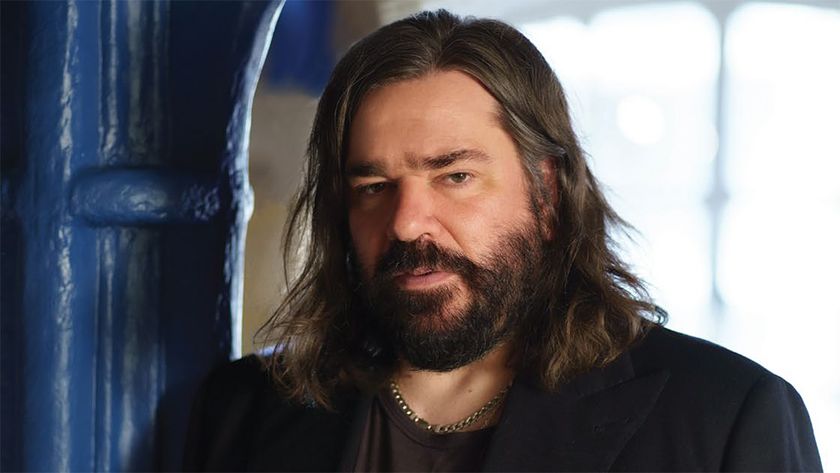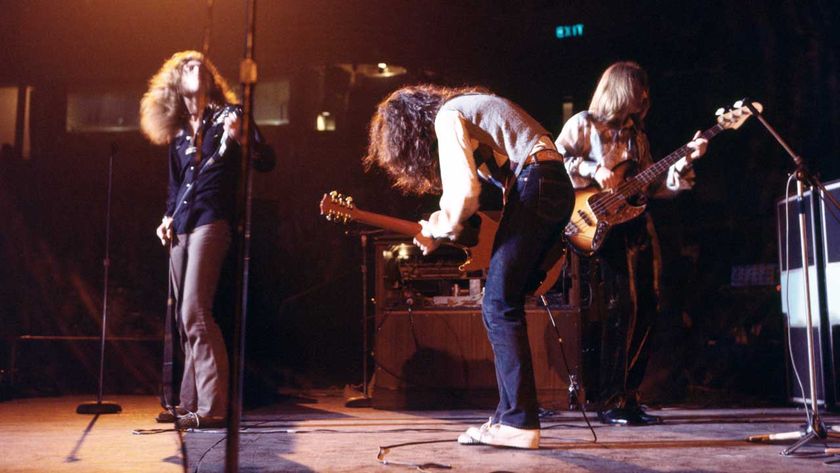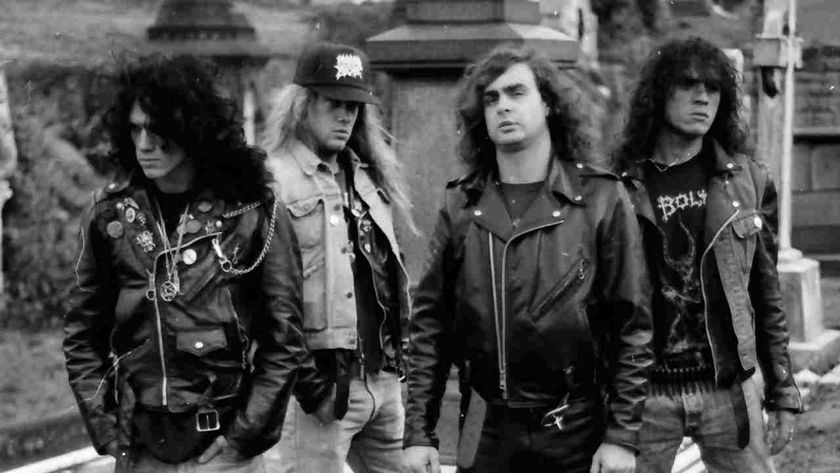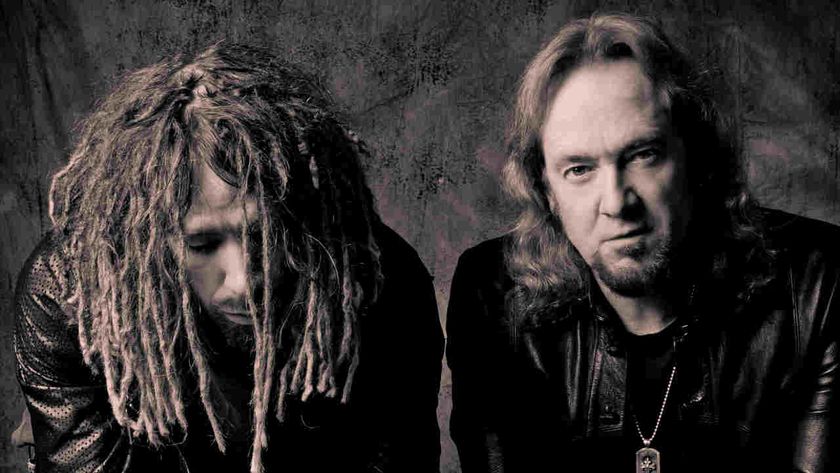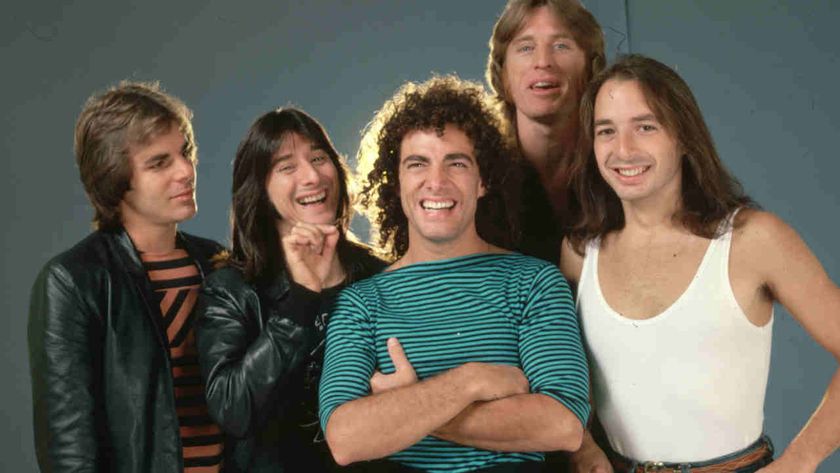To quote 50 Shades Of Grey’s titular, cardboard cut-out of a character: ‘My desires are… unconventional.’ This is, by and large, the mindset of most Bloodstock fans. They like their music dirty. They like their music caked in spikes, leather and bodily fluids. Did we hear you kinkily whisper ‘Show me’? Oo-er. Go on, then.
Erected by Paul Gregory and Vince Brotheridge in 2001, the inaugural event was an indoor shindig at Derby’s now-defunct Assembly Rooms, pulling 700 or so punters and resulting in an expected financial loss. Regardless, a second fest was scheduled for the following year.
“From 2001 to 2003, there weren’t any proper UK festivals catering for heavy metal,” explains Vicky Hungerford: Paul’s daughter and the woman responsible for booking Bloodstock’s stellar line-ups. “We had a captive market; there was no Download, nor smaller ones like Damnation or Hammerfest. We captured a niche and that built our reputation quite quickly.”
Attendance roughly doubled in 2002 thanks to power metal troupe Blind Guardian, an act who were, at the time, virgins to the UK gig scene. This trend continued though 2003, with Finnish symphonic metallers Nightwish being thrust into England for the first time.
“I went on tour with Saxon and took my business partner [at the time] with me,” reminisces Paul. “While I was talking to someone else, he went to see Nightwish and was blown away. All a happy accident, really!”
“Nightwish were huge in Europe and that was the point of Bloodstock,” continues Vicky. “When we booked them as headliners in 2003, they’d never played the UK before. Tickets sold out. Even though the capacity was 2500, it was our third festival and our first sell out. People could see this band was important – because tickets were being sold! – but, at the time, nobody was bringing these bands to the UK. It’s massively important that we do that and we’ll always keep doing it. It was momentous. Nightwish helped to establish Bloodstock and get us where we wanted to go.”
And she’s right. Even in its relative infancy, Bloodstock had well and truly arrived. The festival was engorged with more blood, sweat and beers year upon year; a separate outdoor festival was curated in both 2005 and 2006, taking residency in Catton Park and not budging since.
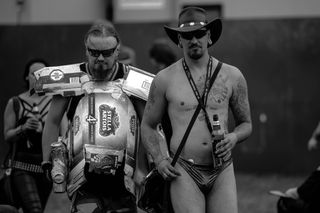
“Obviously as the festival gets bigger, you have to increase the level of the bands,” says Paul, justifying the decision to bring in larger names like Children Of Bodom, whose ascension was tantamount to the festival’s by headlining both 2004’s indoor edition and 2005’s outdoor soiree. “It’s organic growth. You can’t just put on a headliner and expect thousands of people to flock towards it, because that’s a bit naïve. You need to understand the fans and what they want, and you need to have the passion that they have.”
It must be in the genes – or the jeans. Something to do with denim and leather – because the whole family’s in on it. Paul’s other wretched spawn, Rachael Greenfield and Adam Gregory, have each been essential in oiling Bloodstock’s greasy wheels; come 2007, co-founder Brotheridge had left the fold and, to this day, has never been seen in the same room as Batman. So you never know. As Brotheridge was allegedly saving Gotham, all of Paul’s kids were brought on as directors.
“The whole thing is family-run,” states Paul rather proudly, before adding with a chuckle: “My children do all the hard work now, which is the way it should be! We never went in with the intention to make millions of pounds. For my day job as an artist, I’m a creative individual; when I put on the festival, the whole thing has to appeal to me as a creative person. You see the same faces year after year even as it grows, and it’s just got such a nice vibe. If anyone comes up to us we’ll stop and chat, and that’s the atmosphere I want. We’re very supportive of Teenage Cancer Trust and the ethos behind that, too; we just try to keep the whole thing friendly.”
The festival swelled and swelled, securing In Flames – who were touring their world-beating Come Clarity at the time – in 2007 and, controversially, Europe in 2009. You know. Europe, as in, The Final Countdown.
“Initially, there was a massive backlash,” admits Vicky, “because they’re a soft rock band compared to whoever else we usually get. Saying that, I’ve never seen so many men in corpse-paint singing every word to every song. Not just The Final Countdown.”
Bloodstock was being courted by the big boys now. Magazines were extensively covering the fest, tickets were selling like Greggs Steak Bakes on a crispy winter morning and the die had been cast. The festival took a monumental step up in 2010, booking Heaven & Hell – which was, essentially, Dio-era Black Sabbath – and everyone went positively bonkers. Tragically, it was not to be, as the band pulled out and Ronnie James Dio passed away months before the festival.
“It was the ultimate booking, but it was bittersweet,” says Vicky. “Paul has always been good friends with Dio and Wendy [Ronnie’s wife] – he’s known them for many years and painted album covers for Dio – but the fact that Dio wanted to be part of the festival said a lot about Bloodstock and what we’ve been trying to achieve. It was horrific when the news broke that he’d passed away, and it was obviously the right thing to do to rename the main stage. That will never change – it will always be the Ronnie James Dio stage.”
The loss of Dio was a heart-shattering blow to the metal community, but Heaven & Hell’s place amidst Bloodstock’s ranks opened a whole new door. The following year had Motörhead top the bill and, since then, the weightier names of Lamb Of God, Slayer, Megadeth and more have straddled the highest rung aloft Derby’s demonic playground.
“Booking Heaven & Hell was a leap of faith but we had to do it, otherwise we’d just be booking the same bands,” explains Vicky. “It paid off in dividends because we started booking the likes of Machine Head and Alice Cooper, and that’s the only way to grow. It’s been done exponentially over time. We stopped sweating after it all worked out fine.”
Again, she’s right. Bloodstock has obviously increased in size, but still retains that family-friendly vibe it’s always possessed. Spoken in hushed tones, we can even divulge the existence of the guerrilla bin Jousting tournaments, to which Paul replies: “I’ve not seen that. I’ve heard it’s completely insane. As long as they don’t kill each other, it’s perfectly fine! You can’t manufacture that sort of thing – it’s organic, and people keep it alive each year.”
Each line-up has been more or less structurally sound, trimmed down to the essential bands and boasting very little – if any – musical cellulite. This year’s event covers a smorgasbord of styles: Korpiklaani and Ensiferum are on hand to folk shit up; Cannibal Corpse, Belphegor and Fleshgod Apocalypse will provide enough blastbeats to encourage a prolapse from every known orifice; Ihsahn and Trepalium should dish out plenty of deranged dexterity and, to bring Friday to an almighty climax, Trivium have ruffled a few feathers.
“Heavy metal’s got so many sub-genres, so of course you’re going to get people who don’t like a certain band,” says Paul. “Trivium are an awesome band, but you can say what you like as long as you’re not abusive. It’s part of the fans’ passion though, isn’t it? Like: ‘How dare you do that to my festival?’ It’s all part of the deal and I accept it.”
Road To Bloodstock 2015: Trivium
Paul understands that passion because he’s a fan himself. Not content with the greying gods of yesteryear, he’s determined to uncover the next big thing; Bloodstock orchestrate the Metal 2 The Masses competition every year, touring the UK in search of new blood and awarding the blessed few a slot at the festival.
Earlier, Paul mentioned his ‘day job’ as an artist. He’s being modest. Albums by Saxon, Blind Guardian, Molly Hatchet and others have been emblazoned with Paul’s frankly epic landscapes, inspired largely by the master-works of J.R.R Tolkien. Last year’s RAM Gallery at Bloodstock was a grandiose affair – with this year’s set to be even better – but, just like the festival itself, crawled upwards from humble beginnings.
Paul Raymond Gregory: fantasy and festivals
“It was all on a rickety fence – not a good idea at the time,” laughs Paul, harking back to his original gallery at Bloodstock’s indoor incarnation. “I wanted to make more of a statement this time; heavy metal and fantasy are just so linked. Look at Amon Amarth: a Sindarin name for Mount Doom. It’s Tolkien. The list of bands he inspired is huge, and the fact that one of my Tolkien paintings got me into painting heavy metal album covers just made the link so obvious. The most important thing is to support new artists and bring the arts together, though; we’ve got two authors and two photographers there this year. It’s something different, and it surprised people that we had a professional gallery with a wooden floor and proper lighting in the middle of a field!”
Bloodstock is a bizarre beast. From its home-made debut to the lavish productions it puts on nowadays, it has never compromised and has never succumbed to corporate teasing. It’s a family-run, independent celebration of all things heavy and it shows no signs of slowing down. So we’ll see you in the pit, yeah?
